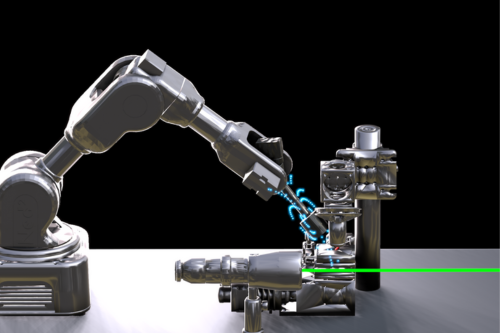A newly developed robotic arm has the potential to accelerate and enhance quantum research, offering scientists greater speed and adaptability. This innovation may serve as a crucial factor in unlocking significant breakthroughs in the field.
 A robotic arm wielding a permanent magnet is used to navigate complex optomechanical assemblies and calibrate a single atom-like quantum sensor. Image Credit: University of Bristol.
A robotic arm wielding a permanent magnet is used to navigate complex optomechanical assemblies and calibrate a single atom-like quantum sensor. Image Credit: University of Bristol.
Developed by researchers at the University of Bristol’s Quantum Engineering Technology Labs and Bristol Robotics Laboratory (BRL), the invention boasts a distinctive design that enables the execution of quantum experiments with unparalleled levels of speed, precision, and intricacy. Quantum technology holds vast potential for real-world applications, ranging from advancements in cellular monitoring for health purposes to interstellar communication.
Quantum experiments often demand highly controlled environments, involving factors such as ultra-low temperatures, atomic-scale interactions, and precisely aligned laser beams. The integration of robotic features into these experiments empowers scientists to explore them with heightened prototyping speed, control, and resilience.
The research findings, along with the groundbreaking robotic arm, were detailed in the journal Advanced Science on November 17th, 2023.
We couldn’t have performed this experiment using standard lab components, so we decided to look into robotics. We’ve shown that robotic arms are mature enough to navigate very complex settings. We’re very keen for this technology to improve all sorts of quantum sensing experiments, and hopefully leading to these experiments leaving the quantum optics lab and find further useful applications, like in cell diagnostics.
Dr. Joe Smith, Study Lead Author and Senior Research Associate, School of Electrical, Electronic and Mechanical Engineering, University of Bristol
Drawing inspiration from the rising prevalence of robots in surgical procedures, Dr Smith and his team were motivated by the remarkable ability of these robots to navigate intricate areas of the body with exceptional precision.
This work demonstrates the importance of bringing developments from other fields, in this case robotics, to advance quantum technologies.
Dr. Krishna Coimbatore Balram, Study Co-Author and Associate Professor, Photonic Quantum Engineering, University of Bristol
The robot can position its high-strength magnet in any location within three-dimensional space and at any angle, adeptly navigating around obstacles. By employing tools like electrodes, lasers, and mirrored surfaces, robotic arms have the potential to enhance precision in aligning and manipulating various experimental setups.
Journal Reference:
Smith, J. A., et al. (2023) Robotic Vectorial Field Alignment for Spin-Based Quantum Sensors. Advanced Science. doi.org/10.1002/advs.202304449.